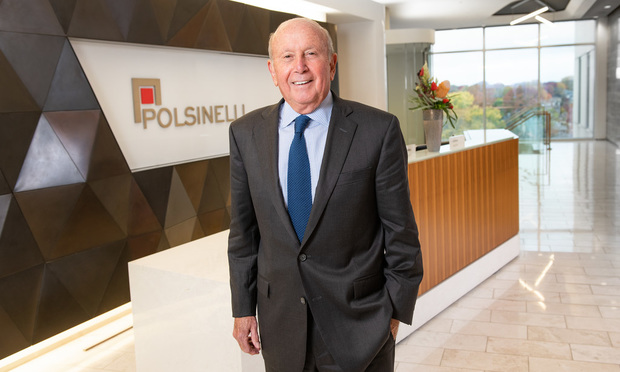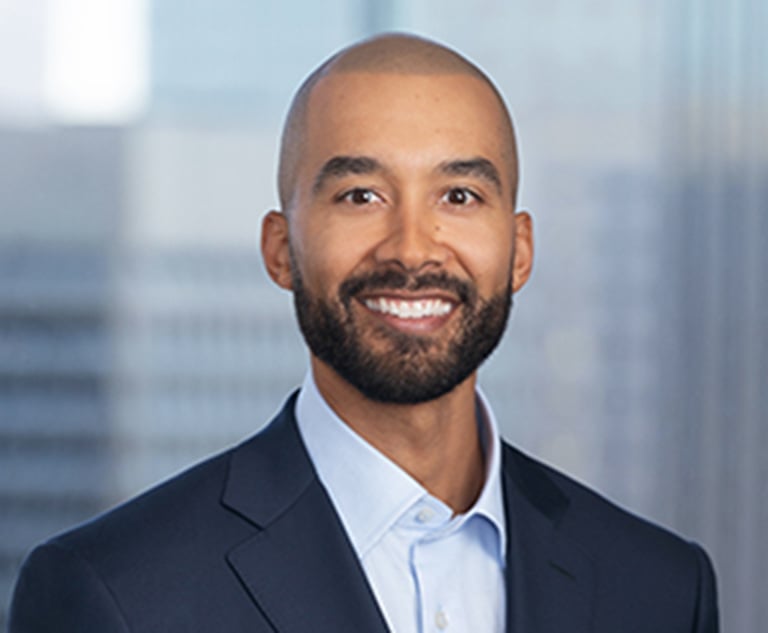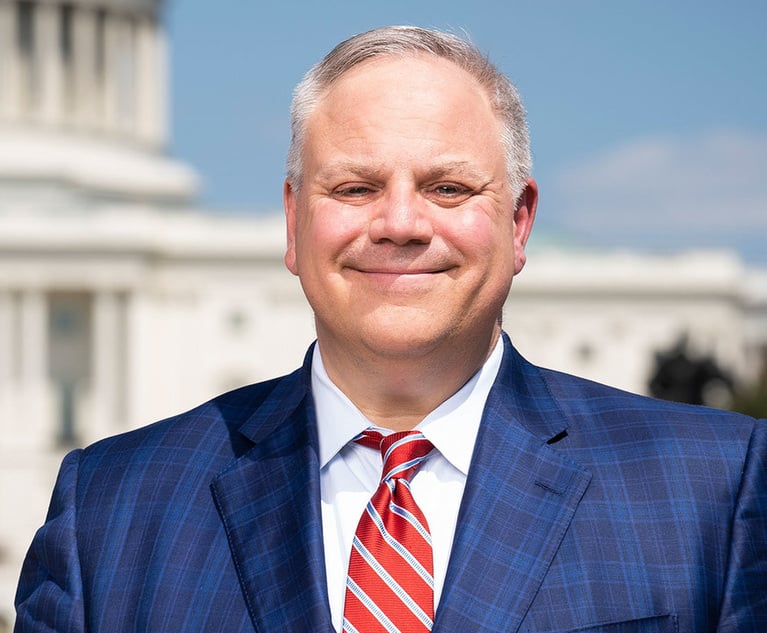Polsinelli Soon Just a Brand Name as Founder Prepares to Retire
One of the increasingly rare Big Law namesakes who still practices law is set to retire next year.
November 02, 2018 at 05:18 PM
6 minute read
 Jim Polsinelli
Jim Polsinelli
Most large law firm names are, and have been for some time, brand names. It is actually somewhat rare that an Am Law 100 firm's name is that of a founding partner.
Up until 1937, when the American Bar Association explicitly said it was “not unethical,” law firms shied away from continuing to use the names of deceased founding partners. So firms like Schiff Hardin, founded in 1864 as Hitchcock & Dupee, have no noticeable connection to founders like Charles Dupee.
But James Polsinelli bucks the trend.
The man who founded Polsinelli at age 28 in 1972 is the rare Big Law founder who still bills clients. That will change on Jan. 31, 2019, when Polsinelli is set to retire and walk away from the firm he has helped grow from a $10,000 credit line to the 69th largest firm in the country, an 800-lawyer behemoth that last year pulled in $475 million in gross revenue.
That the founding partner of one of America's largest firms still practices law says at least a couple things about Polsinelli: His law firm has grown more quickly than almost anyone's (shout-out to John Quinn), and he must like the practice of law.
Liking the practice is the easy part.
Polsinelli, who graduated from the University of Missouri-Kansas City's law school in 1964, got his first legal job working as a trial lawyer in an insurance defense firm. Polsinelli said he quickly realized he didn't enjoy that line of work, and he would later come to realize that it was, at least in part, due to the fact that his client base of insurance adjusters had no personal stake in the outcome of his work.
The practice that Polsinelli would become well-known for could hardly be more different. He advised the owners of middle-market businesses on corporate matters, including transactions, and on issues involving their personal wealth.
“They didn't have any skin in the game,” Polsinelli said of the insurance adjusters. “And when you have a relationship with the owners, they certainly do.”
Polsinelli put his own skin in the game in October 1972, when he and two other lawyers hung out their shingle with the help of a $10,000 line of credit from a bank in Kansas City, Missouri—a note secured by his household goods including pots and pans. The trio took 1,000 square feet of office space above a movie theater.
The firm grew enough that by the early 1980s the group of partners were thinking they needed a strategy. So after consulting Ernst & Young about what a SWOT analysis was composed of (that's strengths, weaknesses, opportunities, threats, for the uninitiated), Polsinelli and about six other partners flew to Las Vegas to sit in a conference room for 25 hours over three days to hammer out a plan.
“Our gamble was the firm,” Polsinelli said.
In a practical effort to promote the nebulous concept of “collegiality,” Polsinelli and the group wrote into the partnership agreement that the firm would never grow past 25 partners.
“We felt we couldn't maintain the collegiality [with more than 25 partners] and we were comfortable with what we were doing and who we were,” Polsinelli said. “How we ever got to 25, I have no idea. But that was the decision at the time.”
The principal reason that changed, Polsinelli said, was their ever-growing relationships with clients. One of those clients asked the firm to open its first office outside Kansas City—in St. Louis—and Polsinelli responded, “Yes, sir, we'll do that.”
Polsinelli the firm, which shortened its shingle to one name in 2013, has since grown to 21 locations and developed one of the better-known national practices in the areas of health care and intellectual property. Polsinelli himself was involved for 25 years in hiring the firm's lawyers, a process that involved visiting campuses and interviewing partners. He said he and his partners had to be “salespeople” while pitching a growing and relatively young firm in an industry dominated by 100-plus-year-old institutions.
Polsinelli said one of his partners, Kenneth Suelthaus, who merged his small firm with Polsinelli in St. Louis, put the challenge of upstart law firms this way: “We weren't presumed capable of getting a piece of business.”
“We had to prove ourselves. Whereas some of the bigger, more established firms didn't have that challenge,” Polsinelli said. “Gradually, we got to the point where in certain areas we are presumed capable and then the question is, 'Are you the right fit?'”
Polsinelli has spent the past two years finding the right fits within his firm to take over his long-term client relationships. He said the process of transitioning his clients has been more time-consuming than he expected.
“Because it means a lot to me that those folks will stay with the firm,” he said. “And hopefully they all will.”
As for his plans after retirement, Polsinelli said he and his wife will spend time on both coasts visiting their four children and six grandchildren.
“And I've got a golf game I've neglected for a long time, so I'll see how much of it I can resurrect,” Polsinelli said. “Other than that, I haven't thought about it much. I just figured I'll get through this process.” He added: “I'm not a very reflective guy anyway.”
Either way, Polsinelli's legacy will likely be reflected in the name of his firm for a long time to come.
Extra reading on the ethical history of law firm names:
The 1928 Canon 33 of the ABA Canon of Ethics states in part: “No false, assumed or trade name should be used to disguise the practitioner or his partnership. The continued use of the name of a deceased or former partner is or may be permissible by local custom, but care should be taken that no imposition or deception is practiced through this use.”
In 1937, that canon was amended to explicitly state that using a deceased partner's name “is not unethical.” The ABA Model Code of Professional Responsibility, adopted in 1969, states in disciplinary rule 2-102(B): “If otherwise lawful a firm may use as, or continue to include in its name, the name or names of one or more deceased or retired members of the firm or of a predecessor firm in a continuing line of succession.”
This content has been archived. It is available through our partners, LexisNexis® and Bloomberg Law.
To view this content, please continue to their sites.
Not a Lexis Subscriber?
Subscribe Now
Not a Bloomberg Law Subscriber?
Subscribe Now
NOT FOR REPRINT
© 2025 ALM Global, LLC, All Rights Reserved. Request academic re-use from www.copyright.com. All other uses, submit a request to [email protected]. For more information visit Asset & Logo Licensing.
You Might Like
View All

Three Akin Sports Lawyers Jump to Employment Firm Littler Mendelson

Brownstein Adds Former Interior Secretary, Offering 'Strategic Counsel' During New Trump Term
2 minute read
Trending Stories
- 1Departing Attorneys Sue Their Former Law Firm
- 2Pa. High Court: Concrete Proof Not Needed to Weigh Grounds for Preliminary Injunction Order
- 3'Something Else Is Coming': DOGE Established, but With Limited Scope
- 4Polsinelli Picks Up Corporate Health Care Partner From Greenberg Traurig in LA
- 5Kirkland Lands in Phila., but Rate Pressure May Limit the High-Flying Firm's Growth Prospects
Who Got The Work
J. Brugh Lower of Gibbons has entered an appearance for industrial equipment supplier Devco Corporation in a pending trademark infringement lawsuit. The suit, accusing the defendant of selling knock-off Graco products, was filed Dec. 18 in New Jersey District Court by Rivkin Radler on behalf of Graco Inc. and Graco Minnesota. The case, assigned to U.S. District Judge Zahid N. Quraishi, is 3:24-cv-11294, Graco Inc. et al v. Devco Corporation.
Who Got The Work
Rebecca Maller-Stein and Kent A. Yalowitz of Arnold & Porter Kaye Scholer have entered their appearances for Hanaco Venture Capital and its executives, Lior Prosor and David Frankel, in a pending securities lawsuit. The action, filed on Dec. 24 in New York Southern District Court by Zell, Aron & Co. on behalf of Goldeneye Advisors, accuses the defendants of negligently and fraudulently managing the plaintiff's $1 million investment. The case, assigned to U.S. District Judge Vernon S. Broderick, is 1:24-cv-09918, Goldeneye Advisors, LLC v. Hanaco Venture Capital, Ltd. et al.
Who Got The Work
Attorneys from A&O Shearman has stepped in as defense counsel for Toronto-Dominion Bank and other defendants in a pending securities class action. The suit, filed Dec. 11 in New York Southern District Court by Bleichmar Fonti & Auld, accuses the defendants of concealing the bank's 'pervasive' deficiencies in regards to its compliance with the Bank Secrecy Act and the quality of its anti-money laundering controls. The case, assigned to U.S. District Judge Arun Subramanian, is 1:24-cv-09445, Gonzalez v. The Toronto-Dominion Bank et al.
Who Got The Work
Crown Castle International, a Pennsylvania company providing shared communications infrastructure, has turned to Luke D. Wolf of Gordon Rees Scully Mansukhani to fend off a pending breach-of-contract lawsuit. The court action, filed Nov. 25 in Michigan Eastern District Court by Hooper Hathaway PC on behalf of The Town Residences LLC, accuses Crown Castle of failing to transfer approximately $30,000 in utility payments from T-Mobile in breach of a roof-top lease and assignment agreement. The case, assigned to U.S. District Judge Susan K. Declercq, is 2:24-cv-13131, The Town Residences LLC v. T-Mobile US, Inc. et al.
Who Got The Work
Wilfred P. Coronato and Daniel M. Schwartz of McCarter & English have stepped in as defense counsel to Electrolux Home Products Inc. in a pending product liability lawsuit. The court action, filed Nov. 26 in New York Eastern District Court by Poulos Lopiccolo PC and Nagel Rice LLP on behalf of David Stern, alleges that the defendant's refrigerators’ drawers and shelving repeatedly break and fall apart within months after purchase. The case, assigned to U.S. District Judge Joan M. Azrack, is 2:24-cv-08204, Stern v. Electrolux Home Products, Inc.
Featured Firms
Law Offices of Gary Martin Hays & Associates, P.C.
(470) 294-1674
Law Offices of Mark E. Salomone
(857) 444-6468
Smith & Hassler
(713) 739-1250









